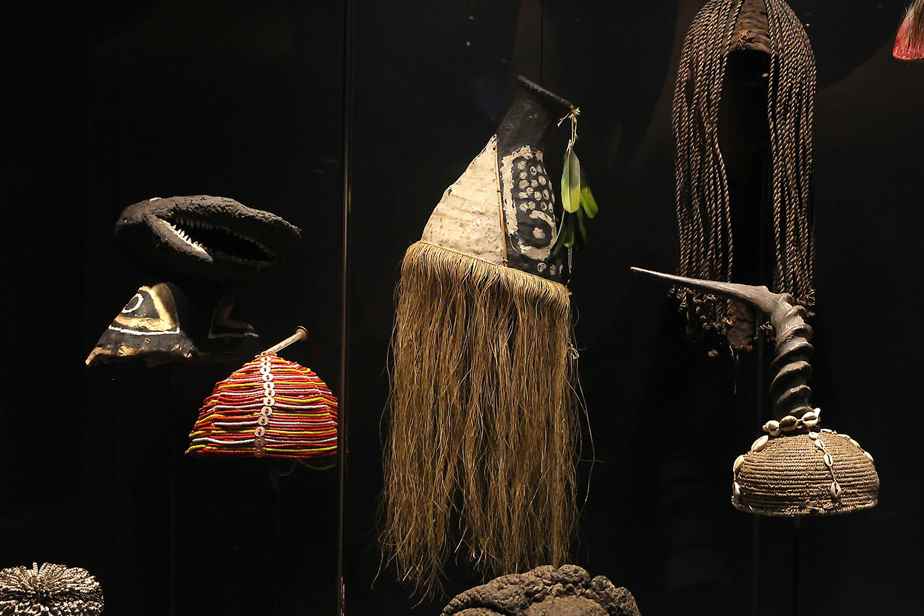The Pointe-à-Callière museum presents the exhibition The world in mind, a collection of over 300 headdresses by the philanthropist Antoine de Galbert. Headdresses and head ornaments that take us to the four corners of the world and make us understand why humanity has been covering its head for millennia.
This exhibition is a real invitation to travel and to discover different cultures through a common object: the headgear, also called headdress, hat, crown, tiara, tiara, hood, headband, toque, turban, helmet . These colorful and sometimes spectacular adornments come from Africa, Asia, Oceania and the Americas.
We discover them through a journey that is divided into 13 themes: there is the headdress to affirm one’s identity or that one wears as physical and symbolic protection, there are the headdresses for combat, dance, show, chief , children and marriage.
We understand throughout the exhibition that these ornaments have different uses; they are practical when it is necessary to protect oneself from the sun or bad weather, but also symbolic when they refer to authority. Without forgetting the bridal ornaments which symbolize prosperity and fertility. For example, in India, West Bengal, the topor is a conical hat worn by the groom which is given by the in-laws to promote the happiness of the couple. In other countries, certain richly decorated bridal headdresses can also be the symbol of an alliance between two families, and endow the woman with a small fortune that she can sell.

PHOTO ROBERT SKINNER, THE PRESS
French collector Antoine de Galbert and Anne Élisabeth Thibault, director of the Pointe-à-Callière museum
“The headdress has several functions, whether social, practical, identifying, symbolic. It celebrates births and marriages, it can claim an act of resistance, honor spirits and ancestors, embody an identity, a territory, the spiritual or political power of a chief,” explains Anne Élisabeth Thibault, general manager of the museum. Pointe-a-Calliere. “This exhibition is the meeting of more than 300 traditions, cultural and personal stories, because these headdresses, close to the body, have an intimate meaning for the people who have worn them”, she says.
All of these adornments on display date from the end of the 19th century.e century at the beginning of the 21ste and are made of different fabrics, silk, feathers, pearls, precious stones, shells, wood, metals, leather, fish scales and even plant fibers.
Discovery while traveling
In 2017, Antoine de Galbert donated his entire collection of headdresses (more than 500) to the Musée des Confluences in Lyon, France, to be preserved and shown to the public. He was in Montreal to testify to nearly 30 years of life traveling the world, in search of hundreds of headdresses and headgear. “I’m from Grenoble and I wanted to travel, and this collection, when you look at it, you go around the world, and it’s great. It is a motionless and inner journey! he says.
Antoine de Galbert was initiated by friends who were lovers of primitive art, and one thing leading to another, he began to buy objects.
I read, worked and learned a lot, and I discovered headdresses which are extraordinary objects. Gradually, it became a collection, a pleasure for the eyes, for the richness of materials and colors and the diversity of cultures.
Antoine de Galbert
Through his many travels, full of surprises and twists and turns, in search of headdresses, he likes to tell this anecdote: “I was in the Grand Bazaar of Istanbul, in Turkey, and I saw this very beautiful silk headdress red with gold thread patterns. The merchant tells me that it is a headdress from an oriental community. I haven’t tried it, but I decided to buy it. This headdress was exhibited in the window of my foundation, then one day, a lady, an expert, told me that it is not a headdress, but a teapot cover! he says, showing it to us in the first room of the exhibition. “It’s really a collection that has been experienced, touched, and you know, it’s by buying that you learn! And I say that without wanting to upset the people in charge of the museum! he laughs.
Particular care has been taken in the scenography of the exhibition. Plays of light as well as a sound universe have been created for each theme. The headdresses are also accompanied by images and videos, which allows a real immersion, but above all to see that these headdresses come to life when they are worn.
“This is an exhibition that is aimed at a very large audience, for the whole family, and which presents headdresses from more than 200 peoples from 50 countries, a fabulous proposition, where we discover the world”, underlines Anne Élisabeth Thibault , Executive Director of Pointe-à-Callière.
The exhibition The world in mind, the collection of Antoine de Galbert is presented until March 12, 2023 at the Pointe-à-Callière museum.
